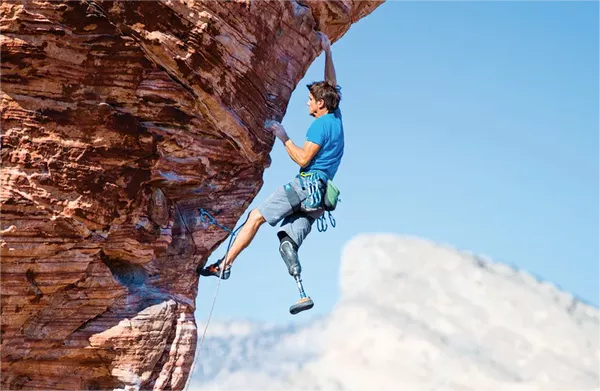Adaptive climbing stands at the intersection of determination, skill, and inclusivity. It is a form of climbing tailored to individuals with physical, sensory, or cognitive impairments, enabling them to experience the thrill and challenge of ascending vertical terrain. Unlike traditional climbing, adaptive climbing incorporates specialized techniques, equipment, and support systems to accommodate a diverse range of disabilities.
Adaptive climbing encompasses a wide spectrum of abilities and challenges. It caters to individuals with spinal cord injuries, limb differences, visual impairments, neurological conditions, and various other disabilities. Whether it’s a congenital condition, acquired injury, or illness, adaptive climbing offers a pathway for individuals to defy perceived limitations and engage with the vertical world.
Benefits
The benefits of adaptive climbing extend far beyond physical exertion. While it certainly enhances strength, flexibility, and coordination, its impact transcends the physical realm. Climbing empowers individuals to confront fears, overcome obstacles, and push boundaries. It fosters resilience, confidence, and a profound sense of achievement.
Moreover, adaptive climbing nurtures mental well-being by promoting focus, problem-solving, and mindfulness. It offers a sanctuary where individuals can immerse themselves in the present moment, leaving behind the pressures of everyday life. The supportive environment of the climbing community cultivates friendships, camaraderie, and a shared sense of purpose, combating isolation and fostering social connections.
Types of Adaptive Climbing
Adaptive climbing manifests in various forms, each offering unique challenges and rewards. Top-rope climbing involves ascending routes while securely attached to a rope anchored at the top of the wall, providing a controlled environment for beginners and experienced climbers alike. Lead climbing adds an additional layer of complexity, requiring climbers to clip into protection points as they ascend, testing both physical and mental agility.
Bouldering, characterized by short, powerful sequences on low-height routes, emphasizes technique, strength, and problem-solving. It offers a dynamic and accessible entry point for individuals seeking to explore climbing without ropes. Paraclimbing competitions provide a platform for athletes with disabilities to showcase their skills and compete at national and international levels, promoting inclusivity and diversity within the climbing community.
Adaptations and Equipment
Central to adaptive climbing is the utilization of specialized equipment and adaptations tailored to individual needs. Climbing prosthetics offer enhanced grip, stability, and support, enabling climbers with limb differences to navigate vertical terrain with confidence. Specialized harnesses and belay systems accommodate varying abilities, ensuring safety without compromising freedom of movement.
Assistive devices such as adaptive footrests, handles, and pulley systems facilitate climbing for individuals with limited mobility or strength. Furthermore, tactile markings and audible cues assist climbers with visual impairments in navigating routes and communicating with belayers. These adaptations democratize access to climbing, empowering individuals to pursue their passion regardless of their physical capabilities.
Getting Started
Embarking on a journey into adaptive climbing begins with finding the right resources and support networks. Adaptive climbing gyms and programs offer tailored instruction, equipment, and community engagement opportunities for climbers of all levels. Online platforms provide directories of adaptive climbing facilities, events, and organizations, facilitating connections and fostering a sense of belonging within the climbing community.
Individuals can also seek guidance from certified adaptive climbing instructors and mentors who possess the expertise and empathy to support their unique needs and goals. Whether it’s a casual session at the local climbing gym or a structured training program, getting started in adaptive climbing is a gateway to personal growth, empowerment, and new horizons.
Community and Resources
At the heart of adaptive climbing lies a vibrant and inclusive community united by a shared passion for vertical adventure. Organizations such as Adaptive Climbing Group, Paradox Sports, and USA Climbing’s Adaptive Committee are dedicated to promoting accessibility, awareness, and advocacy within the climbing community. They offer adaptive climbing clinics, competitions, and outreach programs, empowering individuals to discover their potential and thrive in a supportive environment.
Moreover, online forums, social media groups, and peer networks serve as platforms for sharing experiences, exchanging advice, and celebrating achievements within the adaptive climbing community. Through collaboration and solidarity, climbers with disabilities challenge stereotypes, break down barriers, and redefine the boundaries of possibility.
Challenges and Opportunities
Despite its transformative potential, adaptive climbing faces significant challenges in terms of accessibility, awareness, and funding. Limited resources and infrastructure pose barriers to participation for individuals with disabilities, hindering their ability to access climbing facilities and programs. Moreover, misconceptions and stigma surrounding disability can deter individuals from pursuing adaptive climbing, perpetuating a cycle of exclusion and marginalization.
However, amidst these challenges lie opportunities for growth, innovation, and advocacy. By investing in accessible facilities, adaptive equipment, and inclusive programming, climbing gyms and organizations can expand opportunities for individuals with disabilities to engage with the sport. Educational initiatives and outreach efforts can raise awareness about the benefits of adaptive climbing and promote a culture of inclusivity and acceptance within the climbing community.
Furthermore, collaboration between stakeholders, including climbers, advocates, policymakers, and industry leaders, can drive systemic change and foster a more equitable and accessible climbing landscape. By harnessing the power of collective action and solidarity, we can build a future where adaptive climbing is not just a possibility but a fundamental right for all.
Conclusion
In conclusion, adaptive climbing embodies the spirit of resilience, determination, and inclusivity. It transcends physical barriers, empowering individuals with disabilities to reach new heights and redefine their capabilities. Through its transformative power, adaptive climbing offers not only a pathway to adventure but also a journey of self-discovery, community, and empowerment. As we continue to champion accessibility, awareness, and advocacy, let us climb together towards a more inclusive and equitable future.

